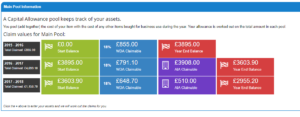Capital Allowances are an invention by the tax man that let you buy a big asset – a machine, a car, furniture, or a tool – and claim relief on your tax bill for it.
Many things like tools let you claim the whole amount back against your tax bill, under what’s called the Anuual Investment Allowance, AIA. (The fact it’s called an allowance gives away that there’s a limit to this: currently £200,000). So your investment in the business is rewarded with a decrease in your tax bill.
Other assets, like a 2nd hand petrol car, won’t be elligible for this allowance, but you can claim a percentage of them back each year. These capital allowances are a way of HMRC letting you reduce your declared profit by taking into account the depreciation of a big asset. Of course, to be fair to all, these depreciation values are mandated (either 8% or 18%).
Sound complicated?
It is. There are several types of asset you might like to purchase, and several ‘pools’ that these need to be written down in. Things get more complex when you’re only using an asset for you business part of the time, for example if you buy a van but 2 days out of 7 you use it for personal use. And then if you come to sell that van when you’ve already claimed tax relief on it.
Don’t worry!
CalCal has it sorted. All you need to do is tell CalCal what you purchased and when. If it’s eligible for Annual Investment Allowance (AIA), it’ll be added to that section on your tax return and taken off your profit. If not, CalCal will keep track of all the ‘pools’ and put them on your tax return. If you use the asset for non-business purposes some of the time, simply slide the slider to indicate a rough percentage.
The Assets report and pool details at the bottom of the Assets page may seem confusing, but it’s just a little CalCal robot keeping track of your capital allowances and adding them all up for you!
More Input!
If you sell an asset, or just stop using it in your business, you must click the ‘sell’ button next to that asset. CalCal will work out if you need to pay any money you’ve already claimed, back to HMRC. It’ll put this on your tax return for you under ‘balancing charges’. Aren’t you glad you don’t have to work this all out yourself?
There’s one more thing you can do in the Assets page: The Advanced section on each asset’s edit box lets you set a valuation and depreciation rate. These are for your non-tax reports, Profit and Loss and Trial Balance. They let you keep track of your business’s real profit if you know that your car is now worth x and each year it actually loses 12% of its value. Feel free to ignore this section, or use it to be super-vigilant.